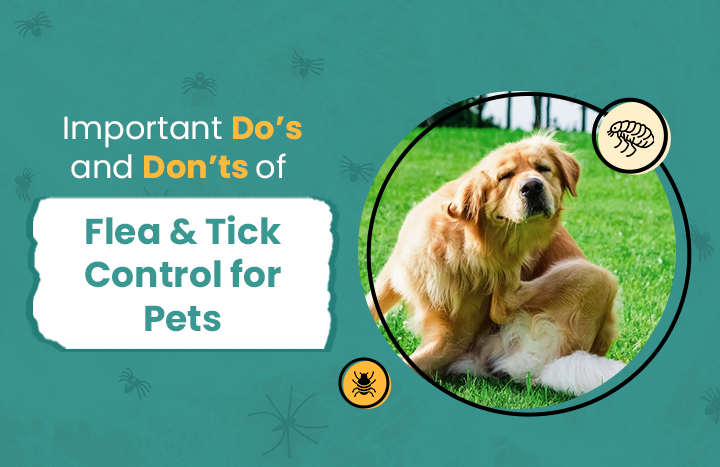
Pets are prone to flea and tick infestations. Therefore, staying on top of flea and tick protection during all seasons is a must. By following an effective routine and using efficient flea and tick preventives, you can easily shield your furry babies from harmful parasites and the health problems that they cause. If you’re new to pet parenthood and not sure about the effective ways to offer flea and tick control to your pal, don’t worry, as we’re here to help. In this blog, we’re happy to highlight the important dos and don’ts regarding flea and tick control for petsto help you establish a safe and effective preventive plan for your beloved pet. Let’s get started.
Importance of Flea and Tick Control for Pets
Flea and tick control is essential to keep your pet protected from the harmful parasites and maintain its overall health, comfort and safety. Flea and tick control also helps with the following:
- Prevention of parasite-borne diseases
- Protection from allergies and skin problems
- Safety of pets as well as their human families
- Year-round comfort and well-being
Dos of Flea and Tick Control for Pets
Let’s look at the recommended practices for the effective prevention of fleas and ticks in pets.
- Always select a product suitable for your pet’s current weight.
- Read the instructions on the product label carefully to achieve optimum results.
- If your pet has a sensitive stomach, is a breeding animal or has a history of seizures, get in touch with your vet before administering a flea and tick treatment.
- You may also seek your vet’s advice to decide on safe and effective treatment combinations for flea, tick, heartworm and intestinal worm control. .
- Ask your vet for advice on tick-repellent and control products if you reside near bushland.
- Check your pet regularly for ticks if you live in a neighborhood where ticks are active.
Don’ts of Flea and Tick Control for Pets
Here are the common mistakes to avoid while offering flea and tick preventives to your pets.
- Administer products labeled for dogs on cats (or vice versa) unless your vet confirms it’s safe, as some formulations are toxic to other species.
- Use flea and tick preventives also during the winter, as your pet needs protection throughout the year.
- Miss doses while administering flea and tick preventives, as it can leave your pet vulnerable to sudden parasite infestations and diseases.
- Double-dosing by using multiple products without veterinary guidance which can increase the risk of adverse reactions.
- Rely on home remedies or household pesticides not approved for pet use, which may be ineffective or harmful.
Choosing the Right Products for Your Pet
Choosing the right flea and tick control treatment for your pet involves several important considerations to ensure effectiveness, safety, and convenience. Here are key factors to help you guide your choice.
- Seek your vet’s advice for recommendations on products tailored to your pet’s species, age, weight, lifestyle and health condition.
- Understand the pros and cons of different types of flea and tick preventives like topical treatments, oral remedies, collars, shampoos and sprays.
- Use products appropriate to your pet’s species, environment and lifestyle.
Seasonal Considerations
Here are some seasonal considerations for you to keep in mind while choosing a flea and tick preventive for your pet.
- Fleas and ticks can be active throughout the year, so year-round prevention is crucial.
- Ticks don’t just thrive in warm weather. They can remain active at temperatures as low as 40°F, so even cooler months may pose a risk of infestations.
- During warmer months, consider administering products that kill parasites faster.
- Seasonal cleaning and yard treatments are crucial as they can complement preventive treatments, particularly during high-risk seasons.
Frequently Asked Questions
- How do flea and tick preventives work?
Most of the flea and tick preventives contain neurotoxic insecticides that target the nervous system of fleas and ticks, paralyzing and killing them.
- What should I do if I miss a dose of a flea and tick preventive?
If you have missed a dose, resume the treatment immediately and seek your vet’s guidance for additional support to ensure continuous protection.
- Are natural flea and tick remedies effective?
Natural flea and tick remedies may offer mild support but generally are not capable of providing full protection. Veterinary-approved products are more reliable, effctive and safe for flea and tick prevention in pets.
- Can indoor pets get fleas and ticks?
Indoor pets are vulnerable to flea and tick infestations as much as outdoor ones. Fleas and ticks can be brought inside via shoes, clothing, or other pets, so prevention is necessary even for indoor-only pets.
- What are the symptoms of flea and tick infestations in pets?
Flea infestation leads to itching, hair loss, red skin, scabs, and visible flea dirt, especially around the lower back and belly.
Ticks, on the other hand, create localized hair loss, small circular scabs, and swelling where attached.
- What are the best flea and tick preventives for dogs and cats?
Some of the best flea and tick preventives for dogs include Simparica Trio, NexGard Chewables, Bravecto Chews, NexGard Spectra and Frontline Plus.
To treat cats, the most recommended flea and tick preventives are Frontline Plus, Credelio, Revolution Plus, Advantage Multi and NexGard Combo.
Ending Note
Effective flea and tick control requires a lot of effort and consistency. Always remember that staying committed to an efficient flea and tick control routine is the ideal way to ensure your furry babies’ good health and happiness.
At DiscountPetMart, we carry a wide range of flea and tick preventives for dogs as well as cats at discounted prices. Check out our online store to enjoy unbeatable offers on your preferred products.

